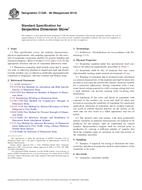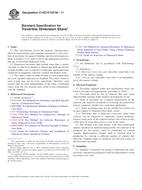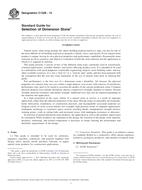Wir benötigen Ihre Einwilligung zur Verwendung der einzelnen Daten, damit Sie unter anderem Informationen zu Ihren Interessen einsehen können. Klicken Sie auf "OK", um Ihre Zustimmung zu erteilen.
ASTM D7625-10
Standard Test Method for Laboratory Determination of Abrasiveness of Rock Using the CERCHAR Method (Withdrawn 2019)
Automatische name übersetzung:
Standard Test Method for Laboratory Bestimmung der Abrasivität of Rock Mit dem Cerchar Methode
NORM herausgegeben am 15.5.2010
Informationen über die Norm:
Bezeichnung normen: ASTM D7625-10
Anmerkung: UNGÜLTIG
Ausgabedatum normen: 15.5.2010
SKU: NS-38851
Zahl der Seiten: 6
Gewicht ca.: 18 g (0.04 Pfund)
Land: Amerikanische technische Norm
Kategorie: Technische Normen ASTM
Kategorie - ähnliche Normen:
Die Annotation des Normtextes ASTM D7625-10 :
Keywords:
abrasiveness, abrasivity, CERCHAR, disk cutter, mechanical excavation, Rockwell Hardness, TBM, ICS Number Code 91.100.15 (Mineral materials and products)
Ergänzende Informationen
| Significance and Use | ||||||||||||
|
The CERCHAR test and associated CAI were developed at a time of more demand for application of mechanical excavation machines at the Laboratoire du Center d' Études et Recherches des Charbonnages de France (CERCHAR) (3). CAI is used to assess the abrasiveness of rock for mechanical excavation. Rock abrasiveness governs the performance of disc cutters, the rate of its replacement and therefore subsequent tunnel costs. Advances in methods of underground excavation, in particular the use of the tunnel boring machine (TBM), necessitates knowledge of rock abrasiveness. Abrasiveness expresses a behavioral characteristic of rock rather than a fundamental physical or mechanical property. CAI tests were originally carried out on natural broken surfaces. In heterogeneous rock types such as conglomerates, coarse grained granite or schistose rock, suitable fresh test surfaces are not achieved by mechanical breakage using a hammer. In these cases CAI values for “smooth” surfaces cut with a diamond saw are acceptable for use but shall be normalized by Eq 2 before they can be used (1). The test velocity for the Original Cerchar apparatus is approximately 10 mm/s and 1 mm/s for the West Cerchar apparatus. The CAI values obtained for both testing velocities (1) are estimated to be equal. Note 1—The quality of the result produced by these practices is dependent upon the competence of the personnel performing it and the suitability of the equipment and facilities used. Agencies that meet the criteria of Practice D3740 are generally considered capable of competent and objective testing and sampling. Users of these practices are cautioned that compliance with Practice D3740 does not in itself assure reliable results. Reliable results depend on many factors; Practice D3740 provides a means of evaluating some of those factors. |
||||||||||||
| 1. Scope | ||||||||||||
|
1.1 This test method covers the determination of the abrasiveness of rock by the CERCHAR Abrasiveness Index (CAI) method. The test method consists of measuring the wear on the tip of steel stylus with a cone shape and known Rockwell Hardness, caused by scratching against a freshly broken or saw cut rock surface for a prescribed 10 mm distance using one of the two test apparatus. 1.2 This test method is intended for freshly broken rock surfaces; however, saw cut surfaces are covered for when a satisfactory rock surface cannot be obtained. 1.3 Stylus Rockwell Hardness (HRC) can have a profound effect on the results and the focus of this test method is an HRC value of 55 for every test (1,2). However, there are situations where stylus with different Rockwell Hardness can be used Therefore, this test method includes discussions on stylus with different Rockwell Hardness. 1.4 All observed and calculated values shall conform to the guidelines for significant digits and rounding established in Practice D6026. 1.5 The values stated in SI units are to be regarded as standard. No other units of measurement are included in this standard. 1.6 This standard does not purport to address all of the safety concerns, if any, associated with its use. It is the responsibility of the user of this standard to establish appropriate safety and health practices and determine the applicability of regulatory limitations prior to use. |
||||||||||||
| 2. Referenced Documents | ||||||||||||
|
Ähnliche Normen:
Historisch
1.2.2014
Historisch
1.6.2014
Historisch
1.1.2014
Historisch
1.2.2014
Historisch
1.1.2011
Historisch
1.11.2013
Empfehlungen:
EEviZak – alle Gesetze einschließlich ihrer Evidenz in einer Stelle
Bereitstellung von aktuellen Informationen über legislative Vorschriften in der Sammlung der Gesetze bis zum Jahr 1945.
Aktualisierung 2x pro Monat!
Brauchen Sie mehr Informationen? Sehen Sie sich diese Seite an.



 ASTM C1405-14
ASTM C1405-14 ASTM C1459-04(2014)..
ASTM C1459-04(2014).. ASTM C1515-14
ASTM C1515-14 ASTM C1526-08(2014)..
ASTM C1526-08(2014).. ASTM C1527/C1527M-11..
ASTM C1527/C1527M-11.. ASTM C1528-13
ASTM C1528-13
 Cookies
Cookies
